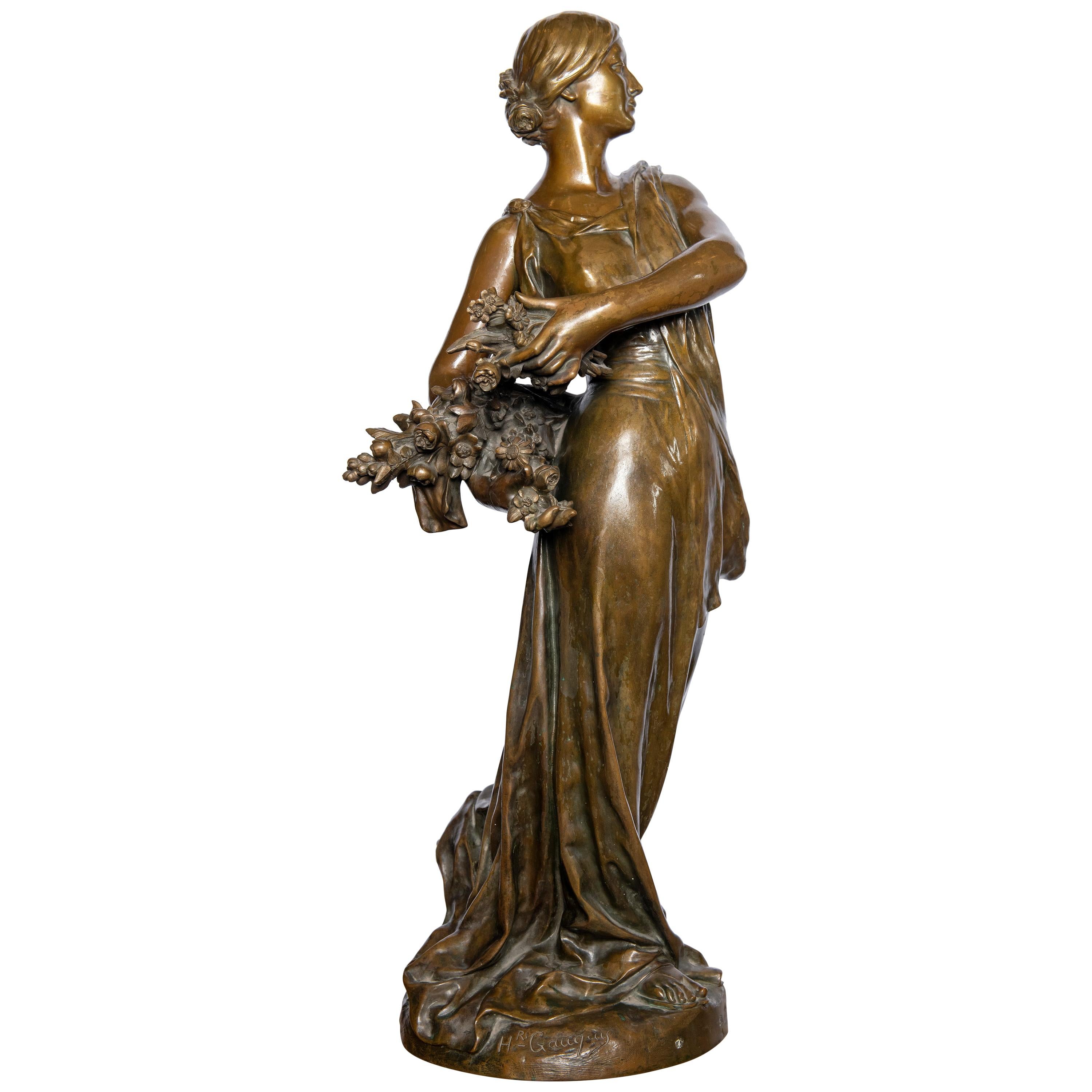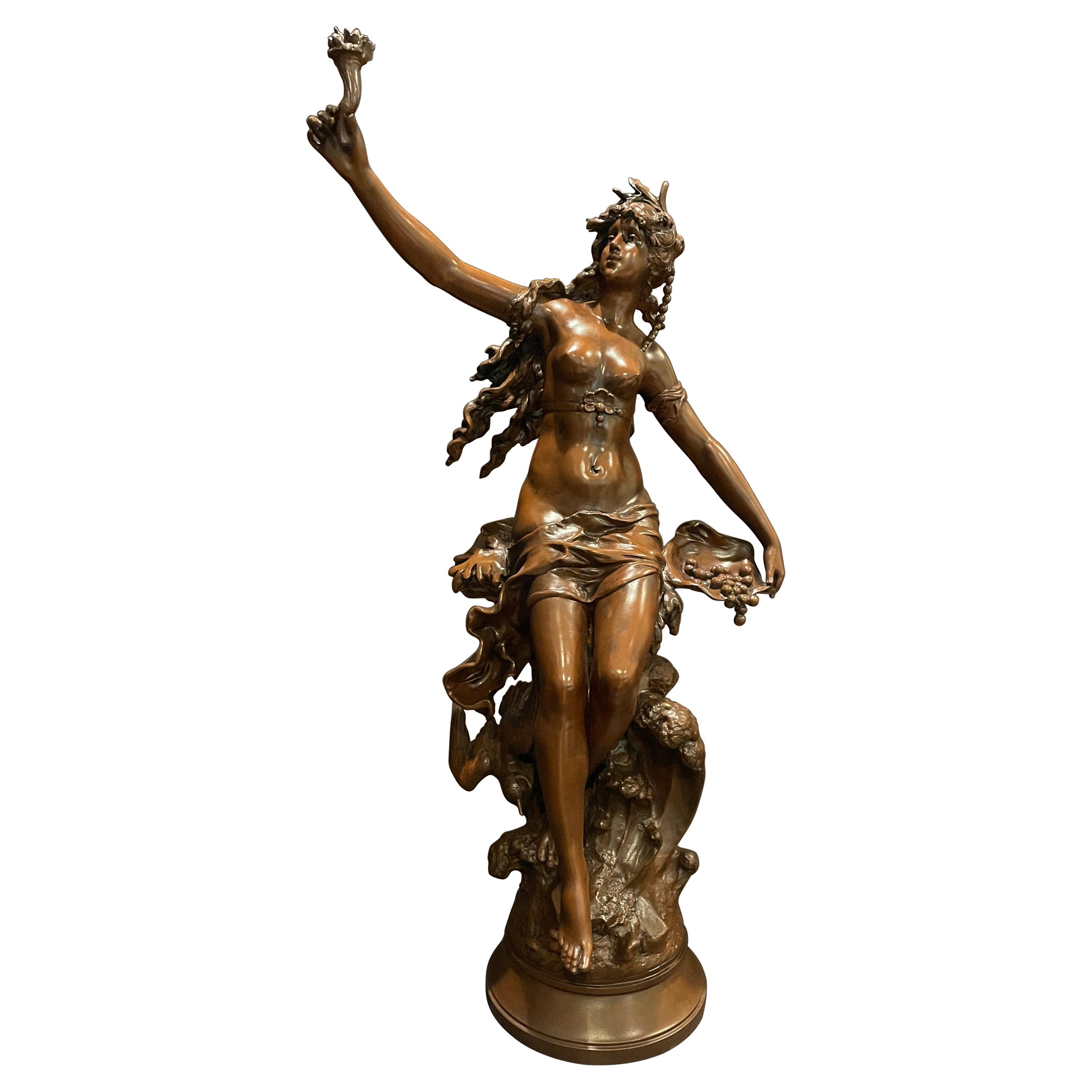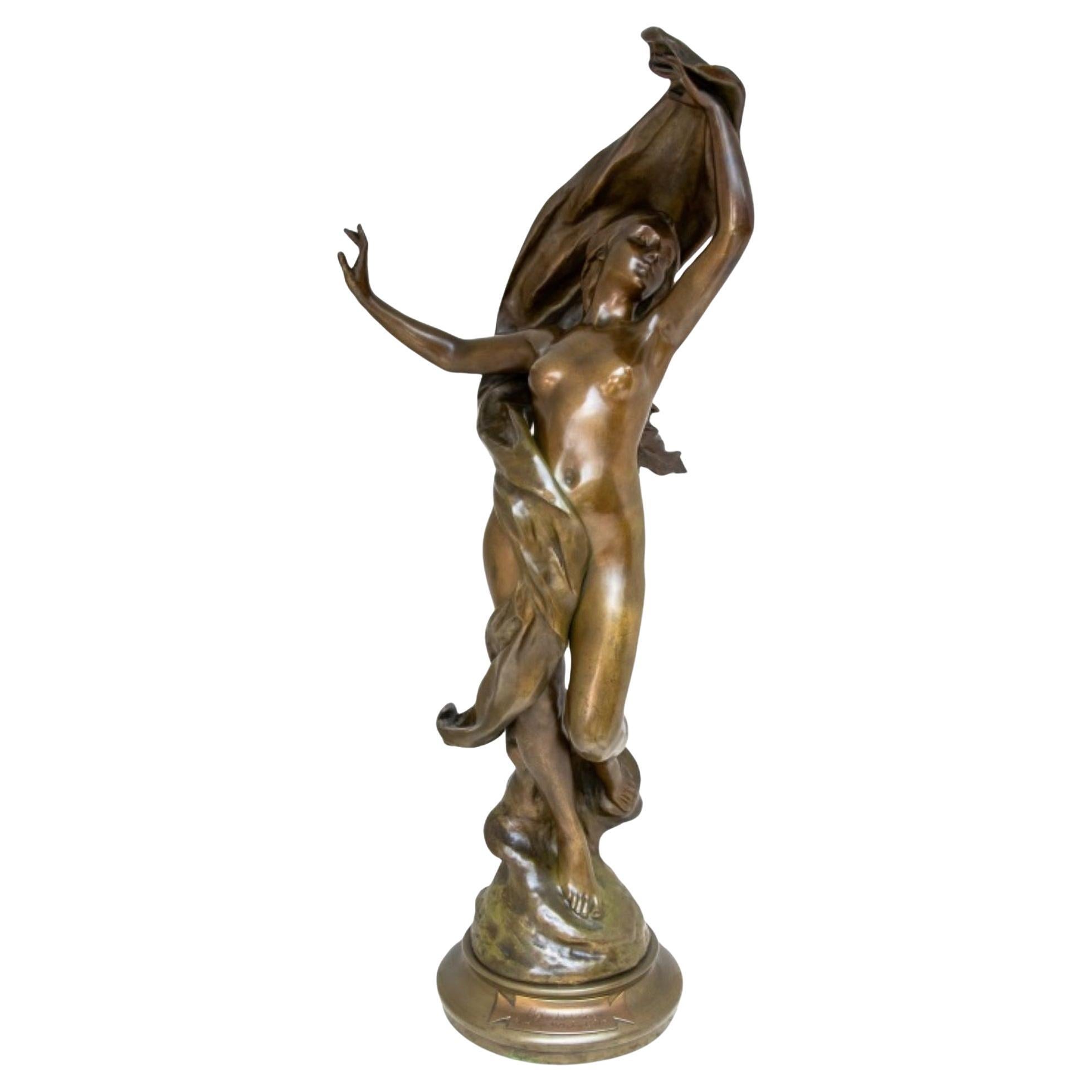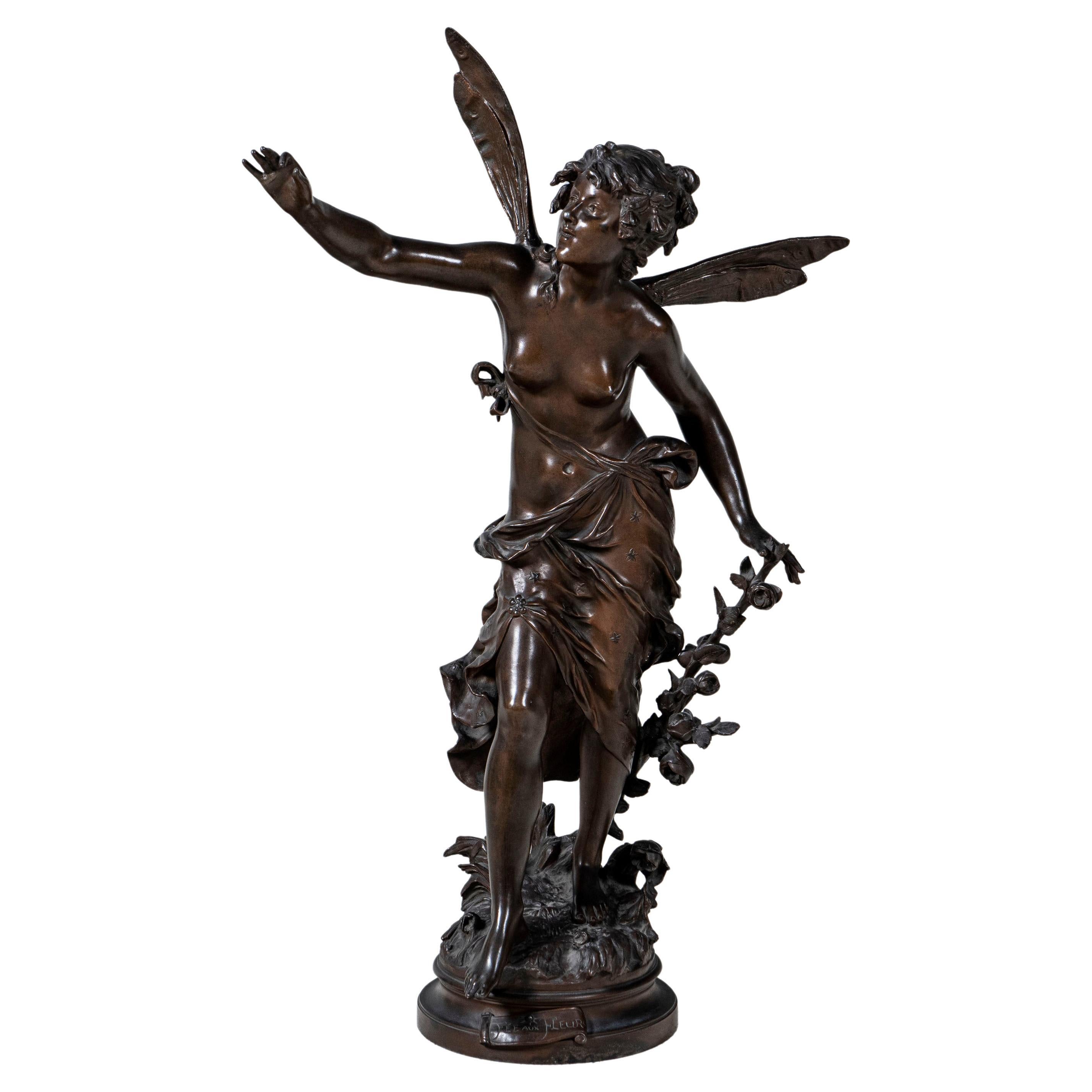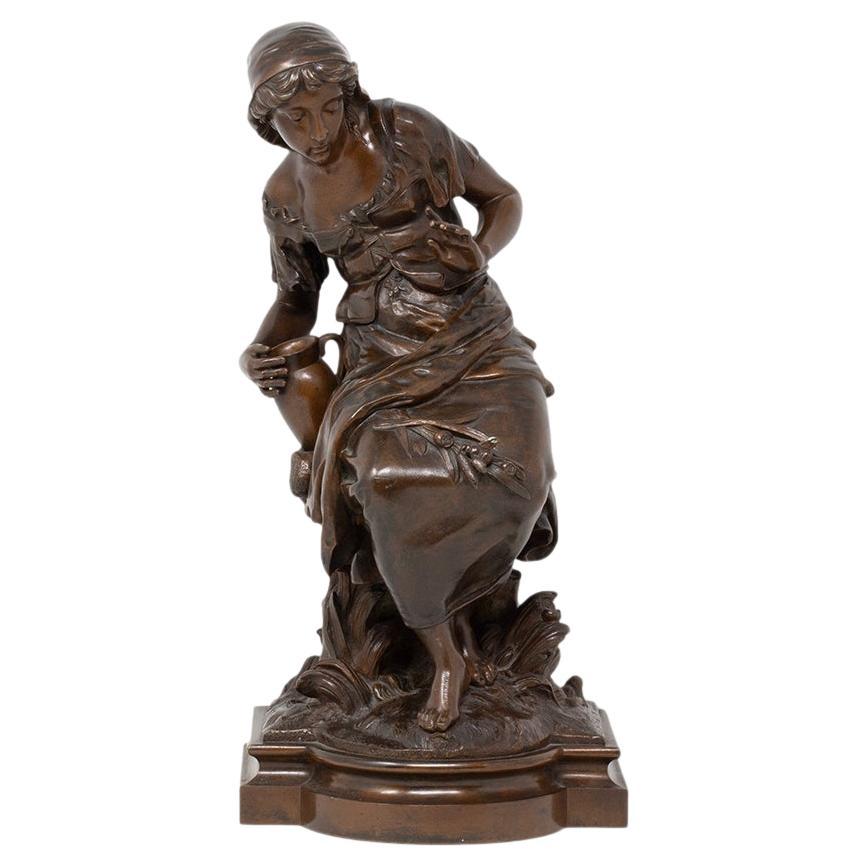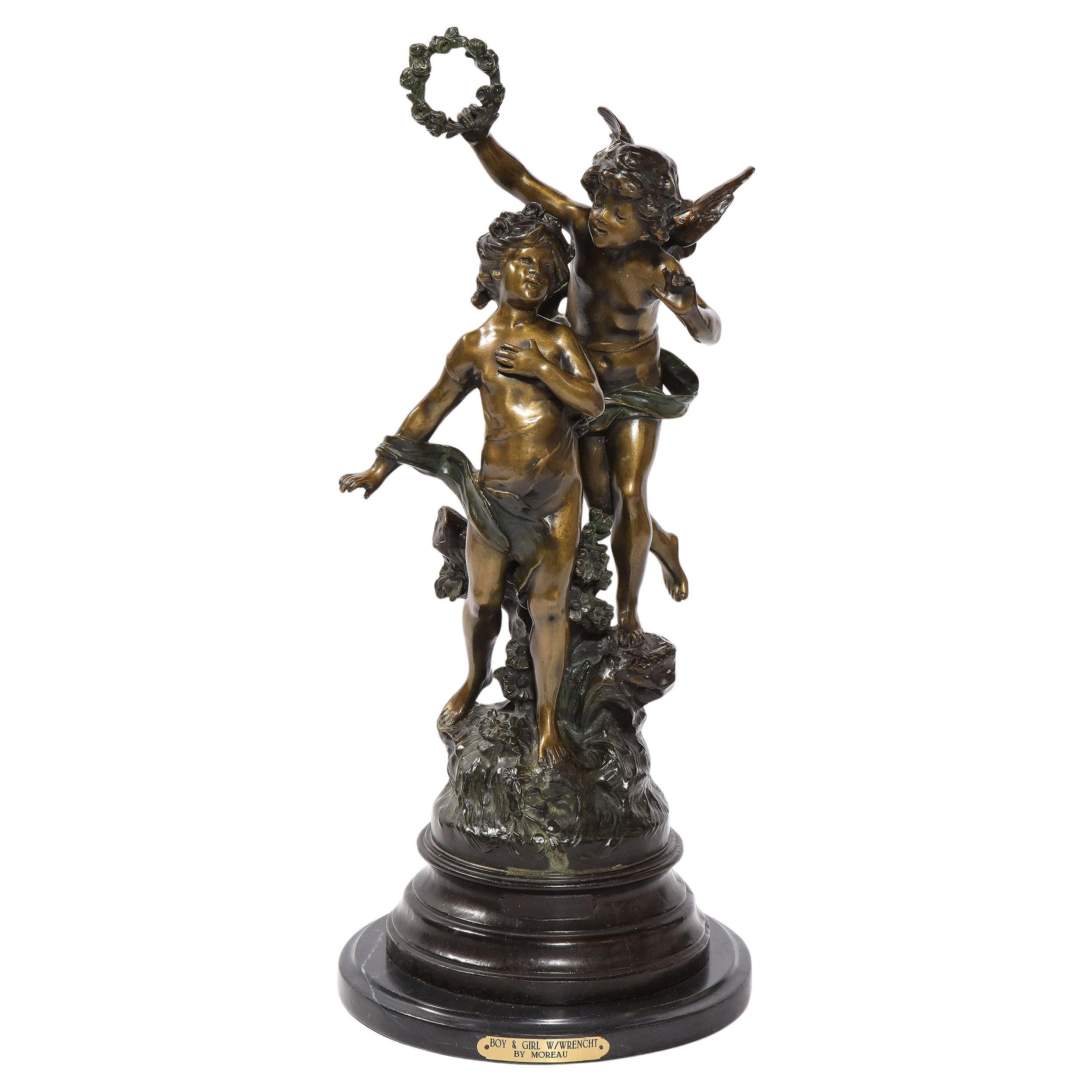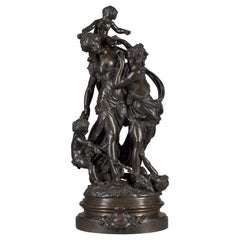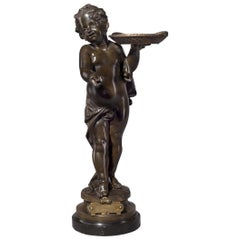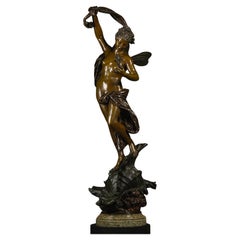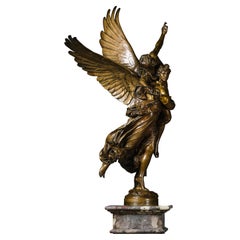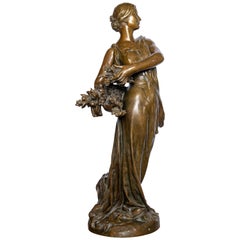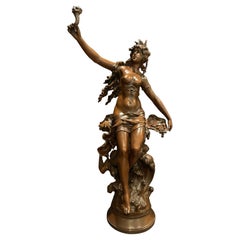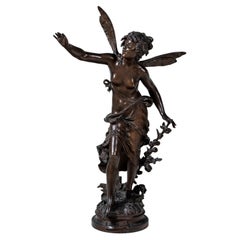Items Similar to 'Grand Nu Aux Feuillages', a Fine Patinated Bronzed Figural Group, circa 1900
Want more images or videos?
Request additional images or videos from the seller
1 of 5
'Grand Nu Aux Feuillages', a Fine Patinated Bronzed Figural Group, circa 1900
$22,028.75
£16,000
€18,845.60
CA$30,178.29
A$33,485.35
CHF 17,540.35
MX$410,620.32
NOK 223,107.19
SEK 210,603.67
DKK 140,543.43
Shipping
Retrieving quote...The 1stDibs Promise:
Authenticity Guarantee,
Money-Back Guarantee,
24-Hour Cancellation
About the Item
'Grand Nu Aux Feuillages', a fine patinated bronzed figural group by Alois Mayer.
German, circa 1900.
Signed 'A. Mayer'.
Alois Mayer (1855-1936) Was a German Sculptor who worked mainly in bronze, creating statues, small sculptures and important public monuments.
Born March 3rd 1855, to Franz Joseph and Regina Mayer, little is known of Alois‘s early life. He studied at the Munich Academy of Fine Arts and made the city his permanent home from 1882. From 1855 he was an assistant professor in the studio of William of Rümann and assisted in the production of the equestrian statue of the Prince Regent Leopold for the Nuremberg Central Station. Other important public monuments included the Bismarck monument in Frankfurt-Höchst and the Alfred Krupp Memorial in Essen.
He was a member of the National Association of Visual Artists in Germany and the Munich Artists' Association.
Bibliography:
Alois Mayer (sculptor). In: Ulrich Thieme , Felix Becker u. a .: General Encyclopedia of Artists from antiquity to the present day. Volume 24, EA Seemann, Leipzig 1930.
- Creator:Alois Mayer (Sculptor)
- Dimensions:Height: 58.27 in (148 cm)Width: 19.69 in (50 cm)Depth: 15.75 in (40 cm)
- Materials and Techniques:
- Place of Origin:
- Period:
- Date of Manufacture:circa 1900
- Condition:
- Seller Location:Brighton, GB
- Reference Number:Seller: B721101stDibs: LU1028012222803
About the Seller
5.0
Recognized Seller
These prestigious sellers are industry leaders and represent the highest echelon for item quality and design.
Established in 1964
1stDibs seller since 2014
58 sales on 1stDibs
Typical response time: 2 hours
Associations
The British Antique Dealers' AssociationLAPADA - The Association of Arts & Antiques Dealers
- ShippingRetrieving quote...Shipping from: Brighton, United Kingdom
- Return Policy
Authenticity Guarantee
In the unlikely event there’s an issue with an item’s authenticity, contact us within 1 year for a full refund. DetailsMoney-Back Guarantee
If your item is not as described, is damaged in transit, or does not arrive, contact us within 7 days for a full refund. Details24-Hour Cancellation
You have a 24-hour grace period in which to reconsider your purchase, with no questions asked.Vetted Professional Sellers
Our world-class sellers must adhere to strict standards for service and quality, maintaining the integrity of our listings.Price-Match Guarantee
If you find that a seller listed the same item for a lower price elsewhere, we’ll match it.Trusted Global Delivery
Our best-in-class carrier network provides specialized shipping options worldwide, including custom delivery.More From This Seller
View All'Bacchantes', a Fine Patinated Bronze Figural Group After Clodion, circa 1870
By Claude Michel Clodion
Located in Brighton, West Sussex
'Bacchantes', a fine patinated bronze figural group after Claude Michael Clodion, French (1738-1814).
French, circa 1870.
Signed 'Clodion' to the base and inscribed 'BACCHANTE...
Category
Antique Late 19th Century French Figurative Sculptures
Materials
Bronze
'Bonne Année, Bonne Santé', a Bronze Figure by Adolphe Maubach, circa 1900
By Adolph Maubach
Located in Brighton, West Sussex
'Bonne Année, Bonne Santé' -A fine patinated bronze figure by Adolphe Maubach.
French, circa 1900.
Signed 'Adolphe Maurbach' and bearing a gilt-bronze title plaque 'Bonne Anné...
Category
Antique Late 19th Century French Figurative Sculptures
Materials
Bronze
A Fine And Large Patinated Bronze Figure Of A Sea Nymph
By Luca Madrassi
Located in Brighton, West Sussex
Luca Madrassi (Italian, 1848–1916)
A Fine And Large Patinated Bronze Figure Of A Sea Nymph, Entitled ‘La Fée Des Mers’ (The Spirit Of The Seas)
The semi clad winged nymph, holding a...
Category
Antique 19th Century Italian Figurative Sculptures
Materials
Bronze
‘Gloria Victis’, A Patinated Bronze Figural Group by Mercié, Cast by Barbedienne
By Ferdinand Barbedienne
Located in Brighton, West Sussex
A Patinated Bronze Figural Group of ‘Gloria Victis’ (‘Glory to the Vanquished’), Cast by Ferdinand Barbedienne from the Model by Marius-Jean-Antonin Mercié (French, 1845-1916).
‘Gloria Victis’ (‘Glory to the Vanquished’).
Bronze, gilt and dark brown patina.
Signed 'A. Mercié', with foundry inscription 'F. BARBEDIENNE, Fondeur. Paris.' and A. Collas reduction cachet. The integral base titled 'GLORIA VICTIS'.
This cast is part of a limited edition by the Barbedienne Foundry.
France. Circa 1880.
‘Gloria Victis’ is one of the most recognisable and important works of sculpture of the nineteenth century and a definitive image of France’s historic national identity. The figure of glory, winged and wearing armour, carries a dying young warrior heavenwards towards fame and immortality. The compositional daring of the group must be admired for balancing two figures on the minimal support of one foot, wings spread in the moment before taking flight.
Mercié was a student at the French Academy of Rome when the Prussians invaded France in 1870. Shortly after the war had begun, he executed a group depicting the figure of Fame supporting a victorious soldier. When news reached Mercié in Rome that the French had surrendered, he decided to alter his group, replacing the victorious soldier with a defeated casualty, thus transforming an allegory of ‘Glory to the Victors’ into one of ‘Glory to the Vanquished’. Completed in 1872, a year after the defeat of French soldiers against the Prussian army, the statue personifies a defeated but heroic France. The title is also a reversal of the famous formula, ‘Vae Victis’ (Death to the Vanquished), which the Gallic general Brennus exclaimed upon defeating the Romans in 390 BC. The figure of the fallen soldier was thought to represent Henri Regnault, a fellow sculptor of Mercié who was killed on the last day of fighting.
Measuring 317 cm. high the original group of ‘Gloria Victis’ was unveiled in plaster at the Salon of 1872. It was bought by the City of Paris for the sum of twelve thousand francs and then cast in bronze by Victor Thiébaut for eight thousand five hundred francs. The bronze was exhibited at the Salon in 1875 and first placed in Montholon Square in the 8th arrondissement. In 1884 it was transferred to the courtyard of the Hôtel de Ville and in 1930, it entered the collection of the Musée du Petit Palais, where it can be seen to this day.
The Thiébaut Frères foundry also cast Gloria Victis bronzes for the cities of Niort (requested 1881) Bordeaux (requested 1883), Châlons-sur-Marne (today, Châlons-en-Champagne; requested 1890), and Cholet (requested 1901). In 1905, the Danish brewer and art collector Carl Jacobsen was permitted to have an exact cast made of the original sculpture in Paris, on condition that the base was made 2 cm lower and bore the inscription “Original tilhører Paris By” (The original belongs to the City of Paris). It too was cast by the Thiébaut Frères foundry. Gloria Victis was one of Jacobsen’s most important and his last acquisition. Today it has been returned to its original position in the Winter Garden at Glyptoteket, Copenhagen, Denmark.
The full-size plaster was shown again at the Paris Expositon universelle of 1878 alongside a bronze reduction by Barbedienne. By this time Antonin Mercié had entered into a commercial edition contract with the Ferdinand Babedienne foundry to produce bronze reductions of Gloria Victis, his most famous work. Gloria Victis is first recorded to have been produced in three sizes and by 1886 Barbedienne’s ‘Catalogue des Bronzes D’Art’ lists six sizes measuring 3/5, 9/20, 7/20, 3/10, 6/25 and 2/10, of the original. These reductions were produced by an invention of Barbedienne’s business partner Achille Collas. The Collas reducing machine was a type of complex mechanical pantograph lathe that enabled sculpture to be mathematically measured and transcribed to scale, in the round, thus making a reduced size plaster from which a bronze could be cast.
Mercié's modern sculpture had become an instant classic, even receiving an entry in the Nouveau Larousse Illustré. The success of the group undoubtedly lay in the fact that it was admired not just on an aesthetic level, but also on a patriotic level, particularly in its commemoration of heroism in defeat. Immediately ‘Gloria Victis’ was recognised as a national artwork, capable of arousing patriotism and casts were ordered from Barbedienne as local memorials commemorating the war’s dead for cities across France. ‘Gloria Victis’ was considered so much a part of France’s national identity that for the 1900 Paris Exhibition, Ferdinand Barbedienne’s nephew Gustave Leblanc, loaned a bronze example to feature as part of l’Exposition centennale de l’art français.
Literature:
For an interesting account of the process of creating a reduction in bronze of the Gloria Victis by Barbedienne and illustrations of the casting and finishing of the bronze see:
'Ferdinand Barbedienne': Theodore Child; Harper's new monthly magazine, Volume 73, Issue 436, September 1886.
‘Contemporary French Sculptors’: The Century, Volume 33, Issue 3, Jan 1887.
‘Modern French Sculpture’: Harper's new monthly magazine, Volume 76, Issue 452,
January 1888.
S, Lami, ‘Dictionnaire des sculpteurs de l'Ecole française au dix-neuvième siècle’, Tome III. G.-M., Paris, 1914, p. 432.
Peter Fusco and H.W. Janson, The Romantics to Rodin: French Nineteenth Century Sculpture from North...
Category
Antique 19th Century French Figurative Sculptures
Materials
Bronze
Bronze Figure of 'La Nature Se Dévoilant Devant La Science'
By Louis Ernest Barrias
Located in Brighton, West Sussex
Bronze figure of 'La Nature se dévoilant devant la Science' by Louis-Ernest Barrias.
Inscribed 'E. Barrias' and with Susse Frères foundry cachet and further Susse inscription.
Thi...
Category
Early 20th Century French Figurative Sculptures
Materials
Bronze
'L'innocence Tourmentée Par L'amour' A Figural Group by Luca Madrassi circa 1900
By Luca Madrassi
Located in Brighton, West Sussex
'L'innocence Tourmentée Par L'amour' - A fine patinated bronze figural group by Luca Madrassi.
French, circa 1900.
Inscribed 'L.MADRASSI.PARIS'.
With Gervais foundry cachet...
Category
Antique Late 19th Century French Belle Époque Figurative Sculptures
Materials
Bronze
You May Also Like
Bronze Sculpture Signed H. Gauquie, France, Late 19th Century
By Henri Desire Gauquie
Located in Buenos Aires, Buenos Aires
Bronze sculpture signed H. Gauquie, France, late 19th century.
Category
Antique Late 19th Century French Art Nouveau Figurative Sculptures
Materials
Bronze
$11,200 Sale Price
20% Off
Large Original 19th Century Patinated Spelter Sculpture by Moreau
By Louis & François Moreau
Located in Norwood, NJ
Large 19th century French sculpture by L. & F. Moreau depicting a young girl holding a bowl of berries seated on cresting waves and a bird in flight. Made of spelter, or pot metal, with a beautiful warm, rich chocolate brown patina. Signature on base: L.&.F. Moreau
L.&.F. Moreau two brothers who were perhaps best known for creating highly ornate clocks...
Category
Early 20th Century French Belle Époque Figurative Sculptures
Materials
Spelter
Henri Godet "L'Aurore" Patinated Bronze Sculpture
By Henri Godet
Located in Astoria, NY
Henri Godet (French, 1863-1937) "La Reveil de L'Aurore" [The Awakening of Dawn] Patinated Bronze Sculpture, early 20th century, on a circular base with applied plaque "La Reveil de L...
Category
Early 20th Century French Art Nouveau Figurative Sculptures
Materials
Bronze
Bronze Alloy Sculpture, Signed L. Moreau, France, Late 19th Century
By Louis Auguste Moreau
Located in Buenos Aires, Buenos Aires
Bronze Alloy sculpture "Fée Aux Fleurs", Signed L. Moreau, France, Late 19th Century.
Category
Antique Late 19th Century French Art Nouveau Figurative Sculptures
Materials
Bronze
French Antique Bronze Sculpture by Eutrope Bouret
By Eutrope Bouret
Located in Newark, England
Lady and the Bee
From our Bronze Sculpture collection, we are delighted to offer this beautiful French Bronze Sculpture by Eutrope Bouret. The Sculpture modelled in bronze with a su...
Category
Antique Late 19th Century French Belle Époque Figurative Sculptures
Materials
Bronze
Fine Patinated Bronze Sculpture by Auguste Moreau
By Auguste Moreau
Located in Lyndhurst, NJ
The two patina bronze sculpture by Auguste Moreau showing a winged boy with another child. Set on a stepped black marble base.
Signed AUG. Moreau in the casting.
Auguste was the thi...
Category
Antique Late 19th Century French Belle Époque Figurative Sculptures
Materials
Bronze
More Ways To Browse
Bronze Figural Groups
Antique German Statue
1900 Bronze Statue
Prince Regent
Gold Joseph Mayer
Franz Joseph
Bronze Statue Germany
Bronze Equestrian Statue
Used Furniture In Regina
19th Century Bronze Equestrian Sculptures
Nuremberg Iron
Ulrich Bronze
Chip Carved Furniture
Antique Reproduction Furniture
Art Deco Dance
Art Deco Dancer
Austrian Bronze
Bronze Sculpture European
